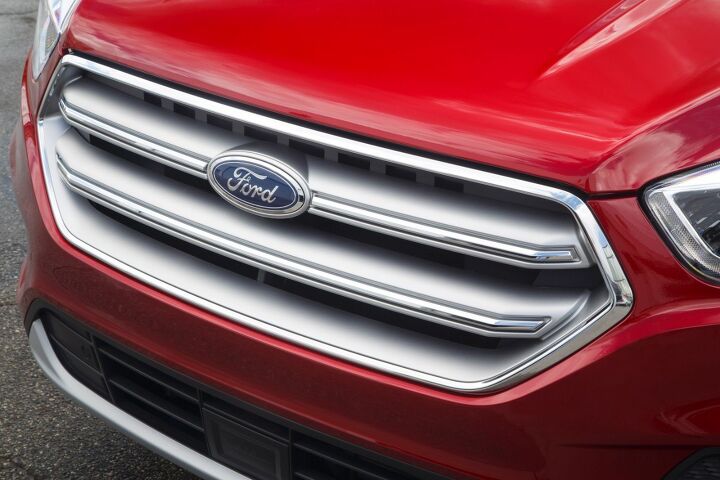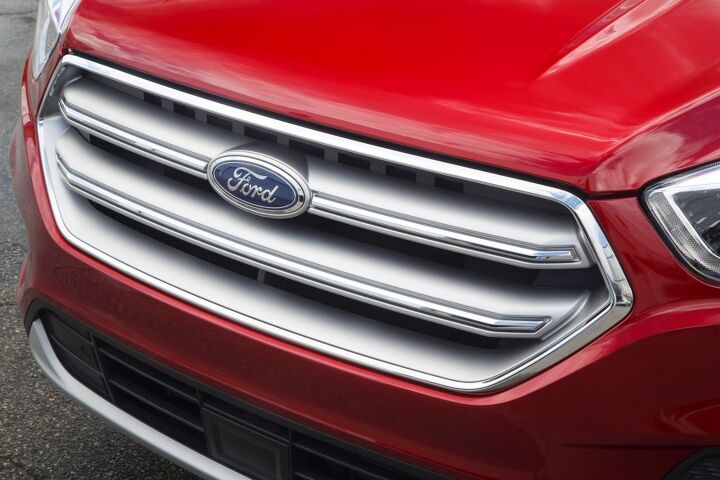#CorporateStrategy
The Show's Over for Four-door Ford Car Advertising
With Ford Motor Company dropping all but one car from its lineup to focus on utility vehicles and crossovers, there’s little reason to run ad campaigns for both. You don’t see Coca-Cola running spots for both Diet Coke and Coke BlāK, as the latter of the two beverages disappeared from store shelves roughly a decade ago. Companies don’t bother pushing products they don’t have, and pretty soon Ford won’t have cars.
Thus, the automaker has ended all nationwide marketing for the Fiesta, Focus, Taurus, and Fusion. Mark LaNeve, Ford’s vice president of U.S. marketing, sales and service, said the automaker intends to use the freed advertising dollars on the company’s current and forthcoming utility models — setting aside a portion for the Mustang. But the Fusion, which is slated to stick around for another two years, will have to go without.
Eternal Underdog: Mitsubishi May Not Sell Enough Cars in the U.S. to Worry About Tariffs
While still an industrial giant on the global scene, Mitsubishi is a shadow of its former self in the United States. After leaning a bit too hard on its status as a value brand, annual deliveries went from about 346,000 units to just 58,000 between 2002 and 2012. Meaningful progress has been made since then, but the road to redemption has been a hard one.
The looming threat of tariffs isn’t making things any easier for Mitsubishi. The automaker doesn’t have a single production facility in the U.S., meaning it will receive the full force of whatever percentage is tacked onto the import fee. There is hope, however. Bizarrely, the brand’s biggest weakness (U.S. sales) is also its greatest strength when it comes to enduring import tariffs.
New Import Duties Could Body Slam Subaru
Subaru is a once-tiny manufacturer that grew in leaps and bounds thanks to high demand from the United States. The automaker is the eighth best-selling brand in the region, despite being a scrappy upstart, and has managed multiply its volume many since the 1990s. But, like any business loaded into a cannon with the word “success” emblazoned on the side, it can’t continue streaming through the clouds indefinitely without encountering some turbulence.
Subaru may be in for troubled times.
The New Plan: Tesla Undergoing Management Weight Loss Program, Reducing Overhead
On Monday, Tesla CEO Elon Musk told employees the company intends to “flatten” its structure. That translates into fewer management executives as the automaker hires as many line workers as possible. Neither should come as a shock to those paying attention. Tesla Motors has bled high-ranking executives for a while now, and the autonomous assembly system that was supposed to revolutionize production hasn’t appeared yet.
Flattening the company’s management structure may be less about cutting costs and more about having no one to fill empty seats. That said, Musk’s announcement placed an emphasis on improving the company’s finances — echoing statements made during an earlier conference call that created some public relations hiccups. So the restructuring plan could be Tesla performing double duty.
“To ensure that Tesla is well prepared for the future, we have been undertaking a thorough reorganization of our company,” Musk said in his memo to staff.
Ford Continues Fighting for Europe
Ford Motor Company has a lot invested in Europe. While the continent spent decades operating facilities under the lose leadership of Ford of Britain, Detroit acquired direct ownership in 1950. From there it extended its influence dramatically, buying up established European manufacturers near the close of the 20th century. But things haven’t always been good; economic hardships have been par for the course and things haven’t been easy in a long time.
Presently, Ford makes around $75,000 in profit for each of its employees in the United States. In Europe, that number is about $4,300 per worker. While we’re sure that makes domestic line workers feel entitled to a small pay increase, the point is that the profit margins across the pond are pretty slim for Ford.
However, unlike General Motors, the company doesn’t want to abandon the region. The automaker says it’s taking a renewed interesting in figuring how to keep profits up and is avoiding any speculation that it might duck out of Europe entirely. But let’s revisit its hardships over the last decade so we can establish a framework for why Ford is having a rough go of it.
Mitsubishi Motors Is Gearing Up to Finally Get Its Act Together
Poor Mitsubishi. Its strange history has ushered in memorable models, an important alliance with Chrysler, success on the World Rally stage, a partnership with Jackie Chan, an epic fuel economy scandal, and building debt that eventually turned it into the sad creature we know today. But there is nothing to say it has to stay mired in that ugly situation. It’s getting ready to crawl out of the dumpster and will be getting plenty of help along the way.
The Renault-Nissan Alliance, which now includes Mitsubishi Motors, announced a reformatting of its executive lineup on Thursday — adding new areas, such as quality and car servicing, where all three companies will work in tandem. Bent on efficiency savings, the Alliance said it will seek to extend its convergence in the areas of purchasing, engineering, manufacturing and supply chains next month (when Mitsubishi also gets its new CEO for North America). The ultimate goal here is to maximize profits that can then used for advanced research and development.
Where does this leave Mitsubishi? In a much better position than it once was. Despite initial concerns that Renault and Nissan would attempt to relegate the brand to Asia, where it’s strongest, the Alliance opted to improve the company’s U.S. dealership network and grow sales by 30 percent to 130,000 units per year.
Ford Takes New Autonomous Fleets and Operating System to Miami
It has begun. Ford is finally ready to launch another batch of its faux-autonomous Domino’s pizza delivery vehicles to assess how people will interact with a self-driving vehicle. False autonomy has become a bit of a gimmick with Ford, but a necessary one. Last year, it disguised a man as a seat to assess how people would respond to a vehicle that only communicated using lights. Now it’s running with a similar strategy in a deal with the famous pizza chain, adding Postmates for good measure.
While the information gleaned from the endeavor is less important, the fact that Ford is already actively working with business partners on autonomous applications is what really matters. It’s laying the groundwork for future business opportunities.
However, if you’re worried that Ford’s pretend self-driving vehicles are a sign that it’s losing the race toward the self-driving car, don’t. In addition to the Domino’s car, the automaker is also launching blue-and-white research vehicles equipped with new self-driving hardware and software technology from Argo AI.
Enter Ford X: Automaker Buying Two More Mobility Companies
Not to be outdone by General Motors’ excursion into autonomy, Ford Motor Company has announced it will purchase two mobility startups: Autonomic, which makes self-driving software; and TransLoc, which makes transit apps.
While Ford says it made a significant investment into the California-based Autonomic last year, it’s now rolling the company into a new team for developing mobility business models called “Ford X.”
This is familiar territory, as the Blue Oval also promised to put around $1 billion into Argo AI last year. The artificial intelligence startup is supposed to help Detroit automaker develop a “virtual driver system” for future autonomous fleets. But will the company’s strategy of acquiring businesses work as it hopes to reshape itself into a different kind of carmaker? Ford thinks so.
Ford CEO Outlines New Vehicle Development Plan, Shifts Investments, Trims Fat (and Models)
After much speculation, Ford CEO Jim Hackett has finally outlined where his company’s dollars will be spent in the foreseeable future. Hackett spent his summer performing what Ford called a “four-month deep dive” into the company’s strategy and business operations to see what changes needed to be made. His conclusions? This may surprise a few readers, but Ford will continue building and selling automobiles.
Alright, that isn’t a bombshell, but the brand is trying to frame itself as the Ford you’ve always trusted while also letting everyone know it’s still a “mobility company” with its eyes fixed on tomorrow. Without the public relations veneer, that plan translates into a reduced number of production models and trims, more money for electrification R&D, less for internal combustion engines, and a significant reduction in material costs.
Hackett’s address also served to reassure the nervous shareholders who ousted his predecessor, Mark Fields. Ford’s stock declined more than 30 percent during Fields’ tenure and many complained that his vision of transitioning from a traditional automaker to a Silicon Valley look-alike was partly to blame. Hackett did everything in his power to ease those fears.
“We’re going to be in the vehicle business moving both people and goods. Some myth about not being in the car business is gone,” Hackett told Wall Street.
Ford's Autonomous Driving Effort Doesn't End at Pizza Delivery
Earlier this week, we griped about Ford Motor Company’s market research into the validity of self-driving pizza delivery vehicles. Thankfully, that’s not the sole avenue the automaker is exploring. Since abandoning Uber Technologies’ self-driving program in April, Ford’s new vice president of autonomous vehicles and electrification, Sherif Marakby, has spent the summer seeking partners that might want to put autonomous vehicles on the road in the near future.
Meanwhile, Ford chief executive Jim Hackett, who took over in May, is conducting a review of the automaker’s overall strategy, including the heavy investments made into electric and self-driving vehicles that took place under former CEO Mark Fields. While it’s unknown how viable he’ll deem every aspect of company’s Fieldsian mobility plan, early assessments hint he’ll leave Marakby plenty to work with.

























Recent Comments